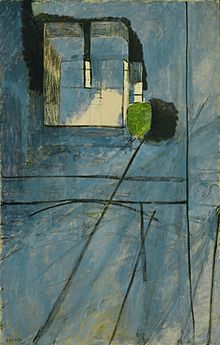
View of Notre-Dame (French: Une vue de Notre-Dame) is an oil painting by Henri Matisse from 1914. It is held in the Museum of Modern Art, in New York.

View of Notre-Dame (French: Une vue de Notre-Dame) is an oil painting by Henri Matisse from 1914. It is held in the Museum of Modern Art, in New York.
Along with works such as Woman on a High Stool , it belongs to the "experimental period" of Matisse's oeuvre. Pentimenti reveal that it was originally painted in a more detailed manner before it was radically simplified into a geometric composition. [1]
It was not exhibited until after Matisse's death, but proved a great influence upon later developments in painting. [1] Specifically, it is said to have considerably influenced American artists who developed new modern and abstract styles, i.e. Color field and Abstract Expressionism, such as Richard Diebenkorn.
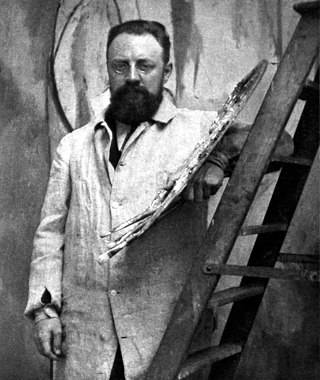
Henri Émile Benoît Matisse was a French visual artist, known for both his use of colour and his fluid and original draughtsmanship. He was a draughtsman, printmaker, and sculptor, but is known primarily as a painter. Matisse is commonly regarded, along with Pablo Picasso, as one of the artists who best helped to define the revolutionary developments in the visual arts throughout the opening decades of the twentieth century, responsible for significant developments in painting and sculpture.

Abstract art uses visual language of shape, form, color and line to create a composition which may exist with a degree of independence from visual references in the world.

Edward Stuart Davis was an early American modernist painter. He was well known for his jazz-influenced, proto-pop art paintings of the 1940s and 1950s, bold, brash, and colorful, as well as his Ashcan School pictures in the early years of the 20th century. With the belief that his work could influence the sociopolitical environment of America, Davis' political message was apparent in all of his pieces from the most abstract to the clearest. Contrary to most modernist artists, Davis was aware of his political objectives and allegiances and did not waver in loyalty via artwork during the course of his career. By the 1930s, Davis was already a famous American painter, but that did not save him from feeling the negative effects of the Great Depression, which led to his being one of the first artists to apply for the Federal Art Project. Under the project, Davis created some seemingly Marxist works; however, he was too independent to fully support Marxist ideals and philosophies.

Richard Diebenkorn was an American painter and printmaker. His early work is associated with abstract expressionism and the Bay Area Figurative Movement of the 1950s and 1960s. In the late 1960s he began his extensive series of geometric, lyrical abstract paintings. Known as the Ocean Park paintings, these paintings were instrumental to his achievement of worldwide acclaim.

Color field painting is a style of abstract painting that emerged in New York City during the 1940s and 1950s. It was inspired by European modernism and closely related to abstract expressionism, while many of its notable early proponents were among the pioneering abstract expressionists. Color field is characterized primarily by large fields of flat, solid color spread across or stained into the canvas creating areas of unbroken surface and a flat picture plane. The movement places less emphasis on gesture, brushstrokes and action in favor of an overall consistency of form and process. In color field painting "color is freed from objective context and becomes the subject in itself."
John Elderfield was Chief Curator of Painting and Sculpture at the Museum of Modern Art, New York, from 2003 to 2008. He served as the Allen R. Adler, Class of 1967, Distinguished Curator at the Princeton University Art Museum and Lecturer in the Princeton University Department of Art and Archaeology from 2012 to 2019.

Dance (La Danse) is a painting made by Henri Matisse in 1910, at the request of Russian businessman and art collector Sergei Shchukin, who bequeathed the large decorative panel to the Hermitage Museum, in Saint Petersburg. The composition of dancing figures is commonly recognized as "a key point of (Matisse's) career and in the development of modern painting". A preliminary version of the work, sketched by Matisse in 1909 as a study for the work, resides at MoMA in New York, where it has been labeled Dance (I).

The Blue Nudes is a series of collages, and related color lithographs, by Henri Matisse, made from paper cut-outs depicting nude figures in various positions. Restricted by his physical condition after his surgery for stomach cancer, Matisse began creating art by cutting and painting sheets of paper by hand; these Matisse viewed as independent artworks in their own right. The Blue Nudes refers also to the editioned multiples based on the cut-outs. Matisse supervised the creation of these lithographs until his death in 1954.

Woman with a Hat is a painting by Henri Matisse. An oil on canvas, it depicts Matisse's wife, Amelie. It was painted in 1905 and exhibited at the Salon d'Automne during the autumn of the same year, along with works by André Derain, Maurice de Vlaminck and several other artists known as "Fauves".

Odalisque With Raised Arms is a painting by Henri Matisse, completed in 1923. The oil on canvas measuring 23 by 26 inches is held in the National Gallery of Art, in Washington D.C.. Matisse's style changed and evolved drastically throughout his career, including his wide and varying collection of paintings depicting female nudes. His odalisque paintings were inspired by his trip to Morocco. Many of the female subjects in the Odalisque paintings were modeled after Matisse's main model at the time, Henriette Darricarrère.

The Red Studio is an oil on canvas painting by French artist Henri Matisse from 1911. It is held in the collection of the Museum of Modern Art, in New York.
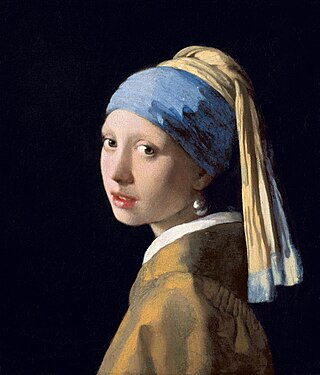
The history of Western painting represents a continuous, though disrupted, tradition from antiquity until the present time. Until the mid-19th century it was primarily concerned with representational and Classical modes of production, after which time more modern, abstract and conceptual forms gained favor.

The Yellow Curtain is a painting by Henri Matisse created in 1915. Its size is 57½ × 38⅛". It is in the collection of the Museum of Modern Art, in New York.

Notre-Dame, une fin d'après-midi is a painting by Henri Matisse from 1902. Its somber coloration is typical of Matisse's works executed between the end of 1901 and the end of 1903, a period of personal difficulties for the artist. This episode has been called Matisse's Dark Period.
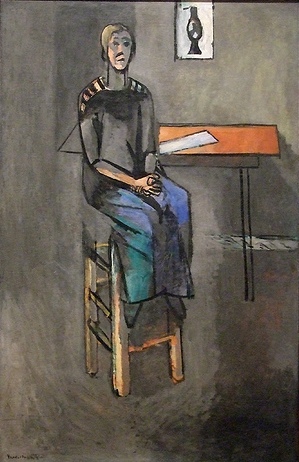
Woman on a High Stool is an oil painting on canvas by the French artist Henri Matisse from early 1914. It is held in the Museum of Modern Art, in New York.

20th-century Western painting begins with the heritage of late-19th-century painters Vincent van Gogh, Paul Cézanne, Paul Gauguin, Georges Seurat, Henri de Toulouse-Lautrec, and others who were essential for the development of modern art. At the beginning of the 20th century, Henri Matisse and several other young artists including the pre-cubist Georges Braque, André Derain, Raoul Dufy and Maurice de Vlaminck, revolutionized the Paris art world with "wild", multi-colored, expressive landscapes and figure paintings that the critics called Fauvism. Matisse's second version of The Dance signified a key point in his career and in the development of modern painting. It reflected Matisse's incipient fascination with primitive art: the intense warm color of the figures against the cool blue-green background and the rhythmical succession of the dancing nudes convey the feelings of emotional liberation and hedonism.
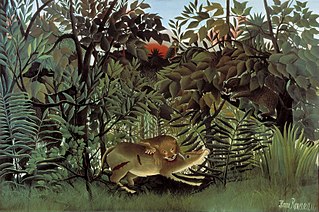
The Hungry Lion Throws Itself on the Antelope is a large oil-on-canvas painting created by Henri Rousseau in 1905. Following Scouts Attacked by a Tiger the previous year, The Hungry Lion was the second jungle painting to mark Rousseau's return to this genre after a 10-year hiatus caused by the generally negative reception to his 1891 painting Tiger in a Tropical Storm.
The year 2010 in art involves some significant events.

Fauvism is a style of painting and an art movement that emerged in France at the beginning of the 20th century. It was the style of les Fauves, a group of modern artists whose works emphasized painterly qualities and strong colour over the representational or realistic values retained by Impressionism. While Fauvism as a style began around 1904 and continued beyond 1910, the movement as such lasted only a few years, 1905–1908, and had three exhibitions. The leaders of the movement were André Derain and Henri Matisse.